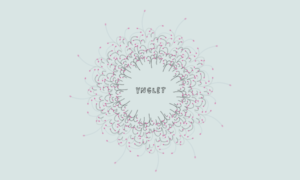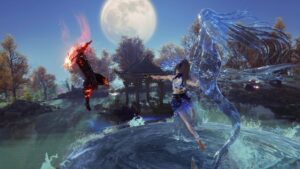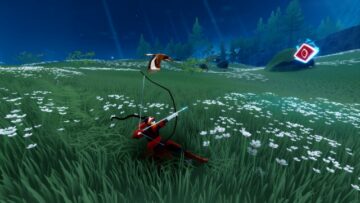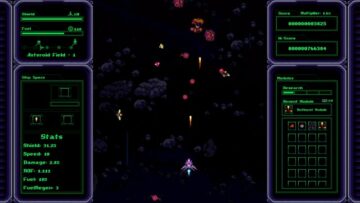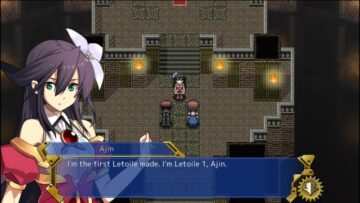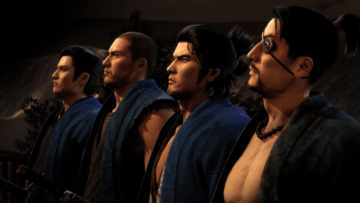There’s a chance that the term ‘MOBA’ might start a panic attack, as it’s so often associated with toxic communities and improbably high skill ceilings. The pressure is on you to git gud, and you have roughly five nanoseconds to do it. But if you’ve been tempted by the genre but bounced out for the reasons we’ve mentioned, then you might want to hit up Warlander. Just don’t expect to be playing it for all that long.
Warlander, you see, moves the emphasis away from personal performance and shifts it over to teamwork and coordination. It’s a forty-player MOBA, in the sense that you and your teammates have a core to protect and a core to destroy – that being your opponent’s. On the way to that core, there is territory to claim, which will generate extra Valor Points (the game’s currency) and valuable respawn points if you do so. It’s a tug-of-war that will have you pushing forward and scarpering back, as you plug flank-points that have been overrun.
In another sense, it’s a large-scale hack-and-slasher, in the vein of Mordhau, Chivalry 2, Dynasty Warriors or SMITE. You pick your choice of three classes, from the ubiquitous Warrior to the support class Cleric and the more ranged and AoE focused Mage. Then you’re thrust into a blooming great map, making the best use of the class’s positives while avoiding their negatives.
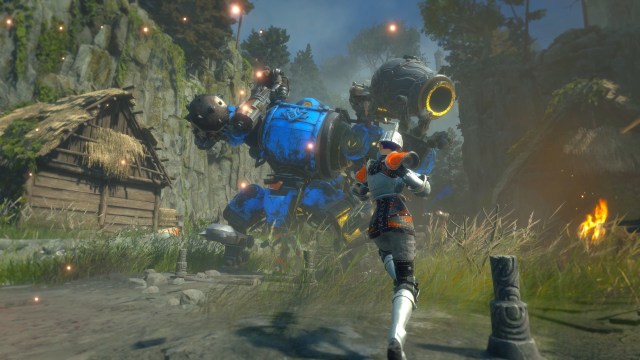

Combining a MOBA and a hack-and-slasher – particularly one that skews to the fantastical, which Mordhau and Chivalry 2 very much don’t – makes Warlander pretty damn unique in our eyes. Who wouldn’t love a world where you can ride medieval mechs into battle, or turn into a tornado and hoover up enemy positions? We found ourselves initially wowed by it, and we would have put good money on us spending weeks dipping in and out. As it happens we were wrong, but more on that later.
Take the setup: you’re drafted into a squad, and then given a vote on your squad role. Assault squads are the Leroy Jenkins’, flanking or making an overwhelming push. Defenders stay back and man the siege engines while glancing at the map to see incoming dots. And speciality teams, well, they’re not great to be on at all, but the intention is that they coordinate to take down specific targets, which the assaulters will probably do anyway.
I loved the social contract this sets up: that you’re given a job and you better stick to it. It was a deep responsibility and I wasn’t going to let the team down. As it happens, probably the most satisfying of these roles – at least in our eyes – was the defender role. The preparation phases allow you to construct your defences (better than most similar games, as there’s the miniest of all minigames to perform to speed up construction), which are good fun to hop into. You can clear out whole squads from the seat of a ballista or a pot of pitch, and Warlander just feels better set up for defensive play.
We loved the loadout management too. You get a ‘deck’ of five characters to bring into each battle. That deck can be made up of any number of Warriors, Clerics or Mages, but you’ll need to be most careful of their XP levels. You see, XP may mean that your unit can carry better equipment and use better abilities, but it also means that they can only be summoned late in the battle, once you have generated enough Valor Points to afford them. If they get killed, then you’re waiting even longer to bring them back. So a balance is needed, as you summon ‘titleless’ troops, do your best to get VP on the board, and then bring out the big guns.
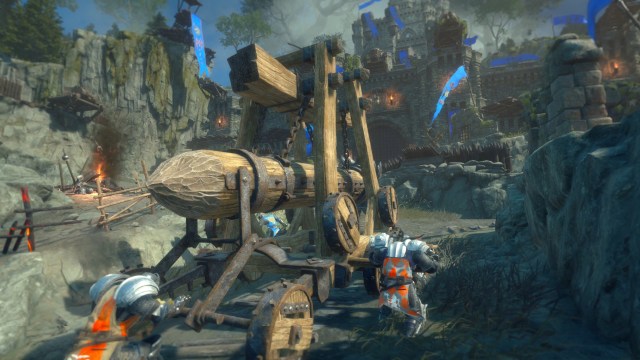

This is pure genius, if only because it levels the playing field at the start, before allowing the better players to wheel out the game changing units earlier than anyone else. That might snowball into imbalance again until you remember that killing one of those units completely hamstrings the opponent: they can’t summon it for yonks and are effectively back to square one. This balance always felt correct to us.
But you could probably note that everything we like about Warlander comes in the moments between the action. Because while it’s got some moves in battle, Warlander attracts some of the adjectives that you never want associated with your game: it’s simplistic, narrow and lacking in depth. The first five or six matches were great, but the following ten or twenty? Not so much.
It’s a compounding effect that comes from a number of things. We just can’t find a way to fall in love with Warlander’s world and characters, least of all our own. It’s a mulchy brown throughout, without anything we’d call personality. Try as we might to bring colour to our avatar, it mostly gets negated by the fact that team colours override them, which made us switch off from wanting cosmetics completely (something that probably damages the MTX sales). The maps are sprawling and there’s a feeling of being in the middle of a large-scale skirmish, but that also dilutes the 40-player count, as you will likely only feature in one-vs-ones.
The combat is mostly a thumbs down from us, too. There’s a weird, imbalanced combat triangle at play, where the Warrior and Cleric can block while the Mage cannot. The thinking is that the Mage needs to reposition, flank, attempt surprise or some other approach, but it mostly just makes them feel like second-class citizens. Couple that with some splashy ranged attacks that don’t have the recoil or impact of FPS counterparts, and you have a meek class. The problem is that the Cleric also feels meek. Healing spells need a target, which seems antithetical to AoE healing, and their melee attacks can’t hope to compare with the powerful Warriors.
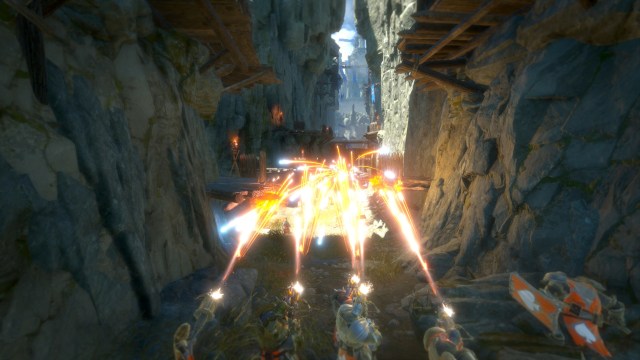

You can see where this is going. The Warrior is a beast, and there’s a reason why they dominate army make-ups. Powerbomb is a de facto starting skill as it can wipe defences if you get close enough. They’re just a level of satisfying above the others, and the result is a lack of diversity in your and the army’s classes.
But combat never truly convinces because it’s mostly just hitboxes bashing at other hitboxes. There’s no real precision or strategy unless you count the single-fire and burst-fire attacks of the ranged Mage, but when melee units can negate you with a single block, and the ‘bullets’ deal the equivalent damage of a mosquito bite, then they don’t meet our expectation either.
There’s undeniably some fun to be had with the large-scale chaos as two fronts clash against each other, and respawns are fast enough that the chaos doesn’t get frustrating. But it’s not a recipe for longevity. We skimmed off Warlander’s shallow surface and couldn’t drum up a reason to come back. The review was the only thing that compelled us.
Being free-to-play, you don’t necessarily have to take our word for it. Warlander is best in its first few games, so give this overblown MOBA a go, experience its best moments and make your choice. Just be prepared for shallowness to bite after the first few hours.
- SEO Powered Content & PR Distribution. Get Amplified Today.
- PlatoData.Network Vertical Generative Ai. Empower Yourself. Access Here.
- PlatoAiStream. Web3 Intelligence. Knowledge Amplified. Access Here.
- PlatoESG. Automotive / EVs, Carbon, CleanTech, Energy, Environment, Solar, Waste Management. Access Here.
- PlatoHealth. Biotech and Clinical Trials Intelligence. Access Here.
- ChartPrime. Elevate your Trading Game with ChartPrime. Access Here.
- BlockOffsets. Modernizing Environmental Offset Ownership. Access Here.
- Source: https://www.thexboxhub.com/warlander-review/
- 1
- a
- abilities
- About
- above
- Action
- after
- again
- Against
- AI
- All
- allow
- Allowing
- also
- always
- an
- and
- Another
- any
- anyone
- Anything
- approach
- ARE
- Army
- as
- associated
- At
- attacks
- attracts
- avatar
- away
- back
- balance
- Battle
- BE
- because
- been
- before
- being
- BEST
- Better
- BIG
- block
- blooming
- board
- bring
- but
- by
- call
- CAN
- carry
- chance
- changing
- chaos
- characters
- Chivalry 2
- choice
- Citizens
- claim
- class
- classes
- clear
- close
- combat
- come
- comes
- Communities
- compelled
- completely
- Construct
- construction
- content
- contract
- Core
- correct
- could
- Couple
- Currency
- damage
- De
- deal
- deep
- defensive
- depth
- destroy
- Diversity
- do
- dominate
- down
- Dynasty
- Dynasty Warriors
- each
- earlier
- Effect
- effectively
- either
- else
- emphasis
- end
- engines
- enough
- equipment
- equivalent
- even
- everything
- expect
- experience
- eyes
- fact
- fall
- fantastical
- FAST
- Feature
- feel
- few
- field
- find
- First
- focused
- Following
- For
- Forward
- FPS
- from
- frustrating
- fun
- game
- Games
- generate
- generated
- Genre
- Get
- Git
- give
- given
- go
- going
- good
- great
- guns
- hack
- had
- happens
- Have
- healing
- High
- HIT
- hope
- hours
- HTTPS
- i
- if
- imbalance
- Impact
- in
- initially
- intention
- into
- Is
- IT
- ITS
- Job
- jpg
- just
- lack
- large-scale
- late
- later
- least
- Level
- levels
- like
- likely
- Loadout
- Long
- longer
- longevity
- love
- loved
- made
- Mages
- make
- MAKES
- Making
- man
- management
- map
- Maps
- matches
- May
- mean
- means
- Medieval
- meet
- Melee
- Middle
- might
- MOBA
- moments
- money
- more
- most
- mostly
- much
- narrow
- need
- needed
- needs
- negatives
- never
- no
- not
- number
- of
- off
- often
- on
- once
- One
- only
- or
- Other
- Others
- our
- ourselves
- out
- over
- override
- own
- Panic
- particularly
- perform
- performance
- personal
- Personality
- pick
- pitch
- plato
- plato data intelligence
- platodata
- platogaming
- play
- players
- Playing
- playing field
- plug
- Points
- pot
- powerful
- precision
- Preparation
- prepared
- pressure
- pretty
- probably
- Problem
- protect
- push
- pushing
- put
- Real
- reason
- reasons
- recipe
- Remember
- Respawn
- responsibility
- result
- review
- Ride
- role
- roles
- roughly
- sales
- satisfying
- SEAT
- see
- seems
- sense
- set
- sets
- Shifts
- similar
- single
- SIX
- skill
- SMITE
- So
- Social
- some
- something
- specific
- speed
- Spending
- square
- start
- Starting
- stay
- Strategy
- support
- Surface
- surprise
- Switch
- Take
- Target
- Team
- teams
- ten
- term
- territory
- than
- that
- The
- The Game
- their
- Them
- then
- there
- These
- they
- thing
- things
- Thinking
- this
- those
- three
- Throughout
- thrust
- to
- too
- truly
- try
- turn
- two
- ubiquitous
- unique
- unit
- until
- up
- us
- use
- valuable
- very
- Vote
- vp
- waiting
- want
- wanting
- war
- Warrior
- was
- way
- we
- weeks
- well
- were
- Wheel
- when
- where
- while
- WHO
- whole
- why
- will
- wipe
- with
- without
- world
- would
- wowed
- wrong
- you
- your
- zephyrnet



